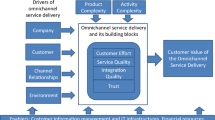Abstract
Modeling a business to match its customer perceived (and customer desired) outcomes, remains an on-going task. This paper considers shows how a service value networks (SVNs) approach may be engaged to model, and deliver, understanding of the front-end business and its direct engagement with its immediate (or front-end) customers. These front-end customers may be either: (1) its off-line, in-store customers — engaging directly with the business sales staff (or representative), or (2) its on-line, virtual customers — engaging with the business via internet or remote access. In this situation, both the business, and the customer draw upon their respective viewpoints, and both sides influence the interaction. External to these business and customer influences are additional factors that capture the immediate and broader global effects — termed environmental effects. These three business-customer engagement areas of influence are captured by a SVN SEM approach.
Without a business-customer encounter of some kind the likelihood of a services business, and a prospecting customer, successfully engaging in an exchange process is reduced. This exchange may be a physical, and/or services exchange, and/or an information and/or ideas exchange. To the business, this encounter is, in effect, a trade, and as a result, the business targets acquiring an economic exchange that will ultimately deliver a net positive economic outcome. To the customer, external and internal information feeds, servicing, perceived value, and satisfaction, are key encounter drivers. SVNs offers a new way to understand the business-customer encounter, and to then utilize this acquired knowledge to either: (1) build a strategic management model, or (2) reengineer its business networks, and to then create a re-positioned, more customer-aligned business operation — one that is capable of delivering win — win, competitive business-customer solutions.
Similar content being viewed by others
References
Brown, S. & Vashistha, A. (2002). Igniting the services value chain. Services Marketing, 11 (1): 12–13
Byrne, B. (2001). Structural Equation Modeling with AMOS. Lawrence Erlbaum Associates, Mahwah, NJ
Chen, I. & Paulraj, A. (2004). Towards a theory of supply chain management: The constructs and measurements. Journal of Operations Management, 22(2): 119–150
Christensen, C. & Anthony, S. (2004). Cheaper, faster, easier: Disruption in the service sector. Strategy and Innovation, 2 (1): 56–65
Cramer, D. (2003). Advanced Quantitative Data Analysis. McGraw-Hill, New York, NY
Cunningham, E., Holmes-Smith, P. & Coote, L. (2006). Structural Equation Modeling: From the Fundamentals to Advanced Topics. Streams Statsline, Melbourne
France, N., Da Rold, C. & Young, A. (2002). Services value chain reshapes IT services industry. Gartner Group Research, AV-21-3090: 1–4
Hair, J., Anderson, R., Tatham, R. & Black, W. (1998). Multivariate Data Analysis, With Readings (5th ed.). Prentice Hall, Englewood Cliffs
Hamilton, J. (2004). Service value networks: Value, performance and strategy for the services industry. Journal of Systems Science and Systems Engineering, 13 (4): 469–489
Hamilton, J. (2005). Service value networks: A new approach to performance and the delivery of services. The E-Business Review, 5 (1): 66–71
Hamilton, J. (2006). Business-customer alignment in the Australian pharmaceutical industry. International Journal of E-Business, 4 (5): 401–420
Hamilton, J. (2007). Service value networks: From theory to practice. The E-Business Review, 7 (1): 1–11
OECD. (2006). Economic survey of Australia, 2006. OECD Economic Surveys, 12: 1–154
Kline, R. (2005). Principles and Practices of Structural Equation Modeling (2nd ed.). Guildford Press, New York, NY
Sampson, S. (2000). Customer-supplier duality and bidirectional supply chains in service organizations. International Journal of Service Industry Management, 11 (2): 348–364
Standage, M., Duda, J. & Ntoumanis, N. (2005). A model of contextual motivation in physical education: using constructs from self-determination and achievement goal theories to predict physical activity intentions. Journal of Education Psychology, 95 (1): 97–110
Author information
Authors and Affiliations
Corresponding author
Additional information
John Hamilton, PhD (Macquarie Graduate School of Management, Macquarie University, Sydney, Australia) is the Director of E-Business at James Cook University. His current prime research interest areas are competitiveness, innovation and the future. He has developed his SVNs concepts into highly agile business approaches — that are capable of near-real-time, business-to-customer ‘customerized’ solutions, whilst also delivering enhanced business competitive advantage. John’s ongoing SVNs research targets services industries (like: education, health and transport), marketspaces, and customerization.
John Hamilton has extensive business, management, consulting, and research experience, and remains a highly active researcher across both off-line and on-line environments. His current specialisations include: strategic innovation; strategic web-based instruments; QFD; business competitiveness; strategic positioning; strategic e-marketing; logistics; service value networks; industry-wide future technologies and solutions; and the performance, value and alignment of customer-business interfaces.
Rights and permissions
About this article
Cite this article
Hamilton, J. Service value networks: Into practice. J. Syst. Sci. Syst. Eng. 16, 414–423 (2007). https://doi.org/10.1007/s11518-007-5057-3
Published:
Issue Date:
DOI: https://doi.org/10.1007/s11518-007-5057-3




